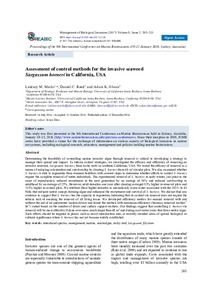| dc.contributor.author | Marks, Lindsay M. | |
| dc.contributor.author | Reed, Daniel C. | |
| dc.contributor.author | Obaza, Adam K. | |
| dc.coverage.spatial | California | en_US |
| dc.date.accessioned | 2020-04-25T16:54:23Z | |
| dc.date.available | 2020-04-25T16:54:23Z | |
| dc.date.issued | 2017 | |
| dc.identifier.citation | Marks, L.M.; Reed, D.C. and Obaza. A.K. (2017) Assessment of control methods for the invasive seaweed Sargassum horneri in California, USA. Management of Biological Invasions, 8, pp.205–213. DOI: https://doi.org/10.3391/mbi.2017.8.2.08 | en_US |
| dc.identifier.uri | http://hdl.handle.net/11329/1301 | |
| dc.identifier.uri | http://dx.doi.org/10.25607/OBP-809 | |
| dc.description.abstract | Determining the feasibility of controlling marine invasive algae through removal is critical to developing a strategy to manage their spread and impact. To inform control strategies, we investigated the efficacy and efficiency of removing an
invasive seaweed, Sargassum horneri, from rocky reefs in southern California, USA. We tested the efficacy of removal as a
means of reducing colonization and survivorship by clearing S. horneri from 60 m2 circular plots. We also examined whether
S. horneri is able to regenerate from remnant holdfasts with severed stipes to determine whether efforts to control S. horneri
require the complete removal of entire individuals. The experimental removal of S. horneri in early winter, just prior to the
onset of reproduction, reduced recruitment in the next generation by an average of 54% and reduced survivorship to
adulthood by an average of 25%. However, adult densities one year after clearing averaged 83% higher in removal plots and
115% higher in control plots. We attribute these higher densities to anomalously warm water associated with the 2015–16 El Niño that reduced native canopy-forming algae and enhanced the recruitment and survival of S. horneri. We did not find any
evidence to suggest that S. horneri has the capacity to regenerate, indicating that its control via removal does not require the
tedious task of ensuring the removal of all living tissue. We developed efficiency metrics for manual removal with and
without the aid of an underwater suction device and found the method with maximum efficiency (biomass removed worker-1
hr-1) varied based on the number of divers and surface support workers. Our findings suggest that controlling S. horneri via
removal will be most effective if done over areas much larger than 60 m2 and during cool-water years that favor native algae.
Such efforts should be targeted in places such as novel introduction sites or recently invaded areas of special biological or
cultural significance where S. horneri has not yet become widely established. | en_US |
| dc.language.iso | en | en_US |
| dc.rights | Attribution 4.0 International | * |
| dc.rights.uri | http://creativecommons.org/licenses/by/4.0/ | * |
| dc.subject.other | Introduced species | en_US |
| dc.subject.other | Sargassum | en_US |
| dc.subject.other | Seaweed | en_US |
| dc.subject.other | Rocky reef | en_US |
| dc.subject.other | Sargassum filicinum | en_US |
| dc.subject.other | Invasive species | en_US |
| dc.subject.other | Management | |
| dc.title | Assessment of control methods for the invasive seaweed Sargassum horneri in California, USA. | en_US |
| dc.type | Journal Contribution | en_US |
| dc.description.notes | Presented at: Proceedings of the 9th International Conference on Marine Bioinvasions (19–21 January 2016, Sydney, Australia) | |
| dc.description.refereed | Refereed | en_US |
| dc.format.pagerange | pp.203-213 | en_US |
| dc.identifier.doi | https://doi.org/10.3391/mbi.2017.8.2.08 | |
| dc.subject.parameterDiscipline | Parameter Discipline::Biological oceanography::Macroalgae and seagrass | en_US |
| dc.bibliographicCitation.title | Management of Biological Invasions | en_US |
| dc.bibliographicCitation.volume | 8 | en_US |
| dc.bibliographicCitation.issue | 2 | en_US |
| dc.description.sdg | 14.2 | en_US |
| dc.description.eov | Macroalgal canopy cover and composition | en_US |
| dc.description.maturitylevel | TRL 8 Actual system completed and "mission qualified" through test and demonstration in an operational environment (ground or space) | en_US |
| dc.description.bptype | Manual (incl. handbook, guide, cookbook etc) | en_US |
| obps.contact.contactemail | lindsay.marks@lifesci.ucsb.edu | |
| obps.resourceurl.publisher | https://www.reabic.net/journals/mbi/2017/2/MBI_2017_Marks_etal.pdf | en_US |
 Repository of community practices in Ocean Research, Applications and Data/Information Management
Repository of community practices in Ocean Research, Applications and Data/Information Management

